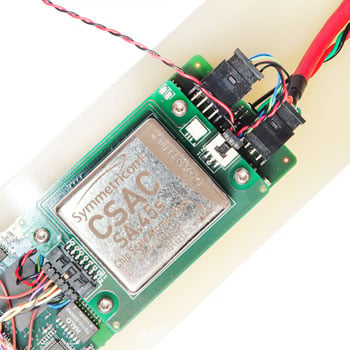Atomic Clock Put in Subsea Acoustic Modems
German robotics company EvoLogics has integrated a chip-scale atomic clock into its acoustic modems to accurately synchronize the nodes of a distributed underwater acoustic network.
 The internal clocks of the network nodes are synchronized with GPS while on the surface and maintain their high precision when submerged.
The internal clocks of the network nodes are synchronized with GPS while on the surface and maintain their high precision when submerged.
EvoLogics engineers worked on atomic clock integration within the framework of the E.U.-funded Widely scalable Mobile Underwater Sonar Technology (WiMUST) research and development project, focused on the engineering of an intelligent distributed underwater array of marine robots for seismic acoustic surveys.
Traditionally, seismic acoustic surveys are performed with a vessel that tows a seismic streamer - a powerful acoustic source and hydrophones on a system of cables. Acoustic waves from the source bounce off the sub-bottom structures and travel back to the sea surface, where the reflections are captured by the hydrophones.
The WiMUST project aims to improve the methods available for geophysical acoustic surveys by “cutting the cable” and decoupling the acoustic source from the system of receivers. A group of autonomous underwater vehicles (AUVs) act as an adaptive receiving array of variable geometry that can change according to the mission. Due to the lack of physical ties between the surface vessel and the acquisition equipment, all mission phases from deployment to recovery are simplified, providing a time- and cost-saving solution for survey operations.
The WiMUST vision is to develop advanced cooperative and networked control / navigation systems to enable tens of marine robots (both on the surface and submerged) to interact by sharing information as a coordinated team.
The first WiMUST experimental tests took place in Sines, Portugal, in November 2016. During the trials, EvoLogics’ atomic clock integration was proven successful, as range-based acoustic positioning of the AUVs was verified with GPS data.
